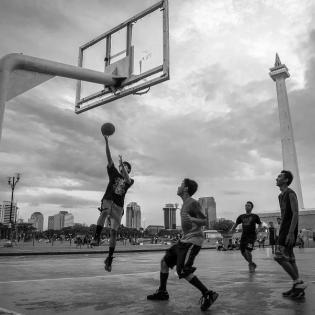Building a Healthy Classroom
Students explore the meanings of community and healthy. While moving around the classroom in an organized game, they have conversations about healthy communities and healthy choices for themselves.
Learners will be able to:
- define healthy and community.
- describe components of healthy living.
- reflect on ways to improve the health of the community.
- community: a group of people who share interests and goals and work together
- contract: a formal, recorded agreement
- health: the state of being in sound body, mind, and spirit
- cooperate: working together toward a common goal
- pledge: (n) a promise
- respect: (n) high or special regard
- advocate: (v) to speak or write in favor in; to support by argument
- community needs: conditions that are essential to improving a community energy: the capacity of acting or being active, available power
- nutrition: the process of nourishing to maintain health and growth
What is your definition or vision of happiness?
What are some things you like about your community? How would you like to see the community change? How could you help it change?
Instructions
Anticipatory Set: "We know that communities can be made up of people who live in the same area. What other characteristics make people members of a community? (Characteristics may include shared interests, common experiences, and racial or ethnic identity.) Write a class definition on the board.
Play a game called Commons that helps students get to know each other as well as introduces them to the concept of community. Put students into random pairs. Give partners two minutes to find three or more things that they have in common, excluding visible commonalities, like gender, skin color, and hair and eye color. Examples include shared favorite subject or sport, favorite color or book, taste in music, number of siblings, desire to travel to Egypt, or hope for world peace.
When each pair has found three things in common, ask that each pair join with another pair, and communicate to find things they have in common among the four of them. Combine groups until the entire class has come together.
Ask the following reflection questions:
- How did playing Commons change the way you think about community?
- How could we revise the definition of community to include what we learned from the game?
Discuss what makes the classroom a community, including physical location, but also listing the shared interests.
Together, determine what behaviors and rules could be in a classroom community contract to maintain a "healthy community." Talk about what that means.
Optional: Write up the terms of a contract on 8 1/2 x 11 paper and duplicate for all participants to sign and date.
Play Mingle, Mingle, Huddle, Huddle to initiate discussions about healthy habits for the community and self. Students walk around and “mingle” until the facilitator calls “huddle” and a number. For example, “Huddle four,” means students quickly form groups of four to discuss one question (choose from below). Ask each “huddle” to share their answer with the whole class and then mingle again. When you call huddle again, they gather with a different group of students.
Questionsfor Mingle Mingle, Huddle Huddle:
- Name a healthy food that you like that you think others won't like.
- Name a behavior that might be difficult but will make the classroom better.
- Why are nutrients important to people? (nutrients in food give us energy and keep our heart beating, our brain active, and our muscles working. Nutrients such as vitamins and minerals also help build and strengthen bones, muscles, and tendons and regulate body processes.)
- Name one habit that you could change today to increase your overall health.
- What is an example of respectful treatment of others? When is it easy to be respectful and when is it hard?
- What healthy foods could you eat more of?
- What is your favorite way to exercise?
- What is your biggest challenge when it comes to staying healthy?
- What is the healthiest place in your neighborhood?
- What is the unhealthiest place in the neighborhood?
- Why do you think people routinely eat unhealthy foods?
When the whole class is together again, ask the following reflection questions:
- What is good health for a person and a community? (Answers will vary, but may include eating the right foods, exercising, not doing drugs or drinking, not smoking, and getting enough sleep. Good health for a community may include showing respect for different perspectives, listening, taking turns, doing your best, taking care of shared property/space).
- What does it mean to be healthy? (Answers will vary.)
Philanthropy Framework
-
Strand PHIL.I Definitions of Philanthropy
-
Standard DP 02. Roles of Government, Business, and Philanthropy
-
Benchmark MS.1 Describe how different needs are met in different ways by government, business, civil society, and family.
-
-
-
Strand PHIL.IV Volunteering and Service
-
Standard VS 01. Needs Assessment
-
Benchmark MS.1 Identify a need in the school, local community, state, nation, or world.
-
-
